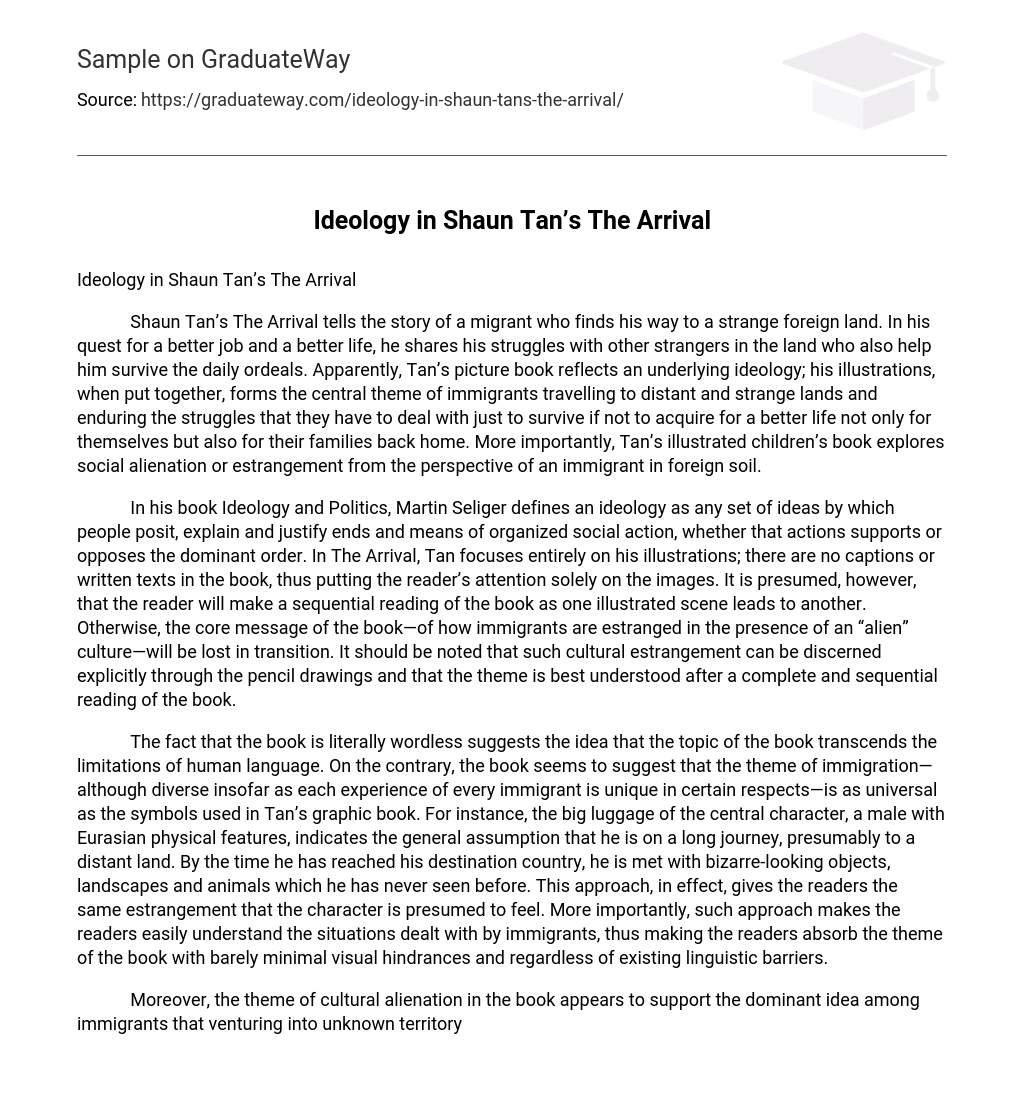Shaun Tan’s The Arrival tells the story of a migrant who finds his way to a strange foreign land. In his quest for a better job and a better life, he shares his struggles with other strangers in the land who also help him survive the daily ordeals. Apparently, Tan’s picture book reflects an underlying ideology; his illustrations, when put together, forms the central theme of immigrants travelling to distant and strange lands and enduring the struggles that they have to deal with just to survive if not to acquire for a better life not only for themselves but also for their families back home. More importantly, Tan’s illustrated children’s book explores social alienation or estrangement from the perspective of an immigrant in foreign soil.
In his book Ideology and Politics, Martin Seliger defines an ideology as any set of ideas by which people posit, explain and justify ends and means of organized social action, whether that actions supports or opposes the dominant order. In The Arrival, Tan focuses entirely on his illustrations; there are no captions or written texts in the book, thus putting the reader’s attention solely on the images. It is presumed, however, that the reader will make a sequential reading of the book as one illustrated scene leads to another. Otherwise, the core message of the book—of how immigrants are estranged in the presence of an “alien” culture—will be lost in transition. It should be noted that such cultural estrangement can be discerned explicitly through the pencil drawings and that the theme is best understood after a complete and sequential reading of the book.
The fact that the book is literally wordless suggests the idea that the topic of the book transcends the limitations of human language. On the contrary, the book seems to suggest that the theme of immigration—although diverse insofar as each experience of every immigrant is unique in certain respects—is as universal as the symbols used in Tan’s graphic book. For instance, the big luggage of the central character, a male with Eurasian physical features, indicates the general assumption that he is on a long journey, presumably to a distant land. By the time he has reached his destination country, he is met with bizarre-looking objects, landscapes and animals which he has never seen before. This approach, in effect, gives the readers the same estrangement that the character is presumed to feel. More importantly, such approach makes the readers easily understand the situations dealt with by immigrants, thus making the readers absorb the theme of the book with barely minimal visual hindrances and regardless of existing linguistic barriers.
Moreover, the theme of cultural alienation in the book appears to support the dominant idea among immigrants that venturing into unknown territory is already a monumental struggle, quite apart from the fact that the urgency of surviving on a daily basis in unknown lands is also a big challenge in itself. Tan’s book presents the singular idea that immigrants are willing to risk life and limb for the sake of getting the most out of life, even if it meant leaving their families behind and succumbing to the real-life threats of total alienation in an unfamiliar cultural setting.
The Arrival also presents stark contrasts between the immigrant’s native land and the new society he lives in. In the foreign land, the male character is not only confronted with unfamiliar objects but also with entirely distinct places such as the market and the city itself. On the other hand, the male character’s native land is portrayed with such familiarity that the readers are expected to easily relate with the images in the character’s own home. In “The Suitcase”, for instance, the reader can easily distinguish the objects that are typically found in households, objects such as a clock, chairs, a table, cups, kettle and bottles to name a few. Moreover, “The City” depicts a seemingly surreal environment although there are hints of a heavily industrialized urban landscape. On the contrary, “The Old Country” illustrates the native land of the immigrant, a rural place that is strongly tied to its traditional and equally familiar customs and beliefs. These things put together would suggest the revelation that there are high contrasts between the immigrant’s native land and the foreign territory he has journeyed to.
That contrast between two landscapes that are parts of the lives of immigrants presents a social dichotomy in general. That is, it presents the unique features between the “old” and the “new”, the “urban” and the “rural”, both of which are prevalent in the concerns of immigrants—immigrants are forced by necessity to think of ways to survive in a “new” and “urban” setting while thinking of the welfare of the families they left behind in an “old” and “rural” homeland. Apparently, immigrants have the choice to reunite with their families either by returning to their native land or by bringing their family with them to live in their “new” land. In effect, immigrants who prefer the latter option are confronted with yet another new form of cultural phenomenon called “cultural assimilation” which is an altogether broad concern. Nevertheless, The Arrival effectively posits the ideology that immigrants shoulder the burdens and the opportunities of living and of working abroad, most often with the help of fellow immigrants. The book also easily conveys the ideology that cultural estrangement is a real circumstance that no immigrant can entirely deny or escape.
It is not at all surprising that the theme of The Arrival can be easily understood not only because the illustrations speak for themselves but also because—and this is perhaps the more important aspect—the entire graphic book is wordless. There are no linguistic barriers present.
Works Cited
Seliger, Martin. Ideology and Politics. New York: Free Press, 1976.
Tan, Shaun. The Arrival. London: Hodder Children’s Books, 2007.
;





